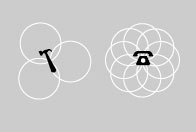PLENTITUDE NOT SCARCITY
The abundance upon which the network economy…
…is built is one of opportunity.
While it is true that every additional email address in the world increases the value of all previous email addresses (that’s the primary effect of plentitude) the increase in value happens because each email address is a node of opportunity, not just an artifact. An email address is more than a way to exchange memos. Because email is rooted in a network, opportunity runs in several directions at once. For instance, once it was realized that mail addresses could be archived easily (opportunity number one), it occurred to someone that they could be collected automatically (opportunity two). They could also be mailed to in bulk (opportunity three). The domain part of the address could be analyzed and used to detect patterns of usage (opportunity four). Addresses in a Rolodex could be updated automatically by the addressee (opportunity five). The address artifact itself could contain more than just a name; it could also hold other facets of interests that the owner was willing to exchange in certain circumstances (opportunity six).

A hammer is part of only a few networks, but a telephone is a part of many. The more networks a product or service can join, the more powerful it becomes.
Contrast this cascading abundance of opportunities with almost any product of the industrial age–say an electric rotary saw, or a color-fast dye, or a maplewood chair. While some of these objects have a few dual uses (the chair could be used as a step stool or to wedge a door open, and the saw motor could be used to drive a drill), they are pretty much limited to their designed intentions. There is no river of opportunities flowing from them. So that even if chairs, dye, and saws were to become universally abundant, their physical plentitude would not change the world much.

